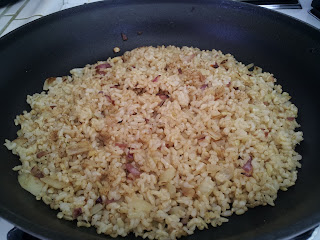Fried Rice-The Lighter Version
Fried Rice-The Lighter Version
There isn't a plate of fried rice out there that I haven't scarfed down with reckless abandon.
My favorite version is what the Japanese call Cha-Han, and it is a very simple affair of rice, sesame oil, sesame seeds, a few diced onions, and scrambled egg tossed in at the last minute.
Lately, though, I have been trying to avoid white rice, because it is a bit starchy and heavy on calories. ENTER...BROWN RICE! What's the difference? Brown rice is loaded with fiber and protein, both of which white rice is lacking in. Here is an quick article from http://www.fitday.com/ that explains the difference in plain English:
When it comes to rice, looks are deceiving. Chefs and food stylists like the attractive, photogenic qualities of fluffy white rice. Brown rice, however, when compared to white rice, wins as the superior choice for a number of other reasons. Much research concludes that color is not the only factor that separates these two types of rice. Brown rice and white rice are different in some very important ways that can affect your health.
Here is a recipe for what I think is a really good version of fried rice that is way healthier and lower in calories than the standard Chinese/Japanese restaurant version. I will warn you though, you have to be very careful not to add too much liquid to the leftover brown rice, or it will become very gummy and unpalatable! You need:
1 tsp. sesame oil
Pam (or other brand) cooking spray
1/2 onion, finely diced
2 cups leftover, cold brown rice
1 tsp. black or plain sesame seeds
3 eggs lightly beaten
1-2 Tbs. soy sauce
1 nonstick skillet heat over a medium high flame
Spray a large skillet with Pam. then add the sesame oil-"But Julie Dear, why the Pam if you are using cooking oil?" I am glad you asked.
The Pam contains something called lecithin. It is an emusifyer, and acts as an agent to help the sesame oil spread out thinly instead of just beading up in one little pool. Swirl the oil around and add the onions. Cook for 3-5 minutes until the onions are browned and translucent. Add the rice and toss. place a lid on your skillet and let the rice cook undisturbed for 4-5 minutes until the bottom is browned and fragrant.
Stir the rice once or twice, if you need to, in order to prevent burning. Toss in the sesame seeds, and remove the rice to a plate and keep warm. scramble the eggs in the pan. Once the eggs are cooked add the rice back to the pan, toss everything together and sprinkle in the soy sauce. give the mix one final toss and serve hot.
This and a bowl of Miso soup are my favorite Meatless Monday Meal!
White Rice: Diabetic Risks
Diabetics are often warned about the link between eating white rice and bringing on a rapid rise in blood sugar levels. The message is that if you are a diabetic or are at risk, stay away from white rice. Medical experts advocate replacing white rice with brown rice if you have diabetes. A study team at the Harvard School of Public Health recently found that eating five servings per week of white rice increased the risk of diabetes. They also found that replacing white rice with brown rice lowered the risk.Brown Rice: Fiber Advantages
Brown rice has more fiber than white rice, and the difference is due to the way both types are processed. White rice is brown rice that has gone through some changes in the milling process. With brown rice, only the husk is removed. White rice is polished and pre-cooked or parboiled. The bran is also removed. The bran is kept intact in brown rice, and that bran gives you a healthy dose of fiber.Brown rice contains nutrients like magnesium, manganese and zinc. White rice has less amounts of these nutrients, but is fortified with iron and some B vitamins. Brown rice is the only form of the grain that contains vitamin E.



Comments
Post a Comment